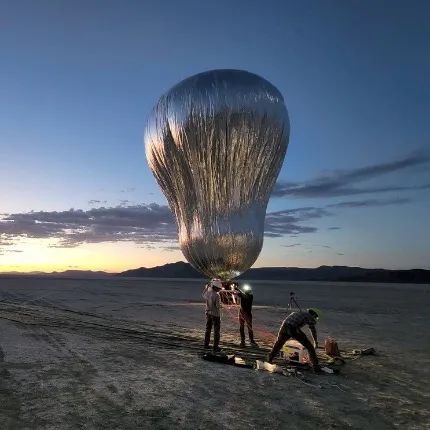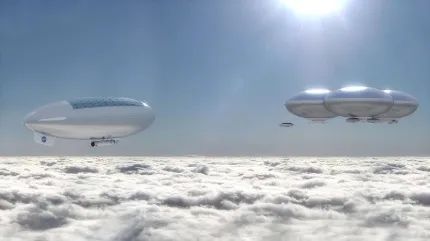Scientists and engineers tested a Venus balloon prototype in Nevada’s Black Rock Desert in July 2022. The scaled-down vehicle successfully completed 2 initial test flights
With its searing heat and overwhelming pressure, Venus’ surface is hostile and unforgiving. In fact, the probes that have landed there so far have only lasted a few hours at most. But there may be another way to explore this dangerous and fascinating world beyond orbiters, orbiting the sun just a stone’s throw from Earth. That’s the balloon. NASA’s Jet Propulsion Laboratory (JPL) in Pasadena, Calif., reported on October 10, 2022 that an aerial robotic balloon, one of its aerial robotic concepts, has successfully completed two test flights over Nevada.
The researchers used a test prototype, a shrunken version of a balloon that could actually one day drift through the dense clouds of Venus.
First Venus balloon prototype test flight
The planned Venus Aerobot is 40 feet (12 meters) in diameter, about 2/3 the size of the prototype.
A team of scientists and engineers from JPL and Near Space Corporation in Tillamook, Oregon, conducted the test flight. Their success suggests that Venusian balloons should be able to survive in the dense atmosphere of this neighboring world. On Venus, the balloon will fly at an altitude of 55 kilometers above the surface. To match the temperature and density of Venus’ atmosphere in the test, the team lifted the test balloon to an altitude of 1 km.
In every way, the balloon behaves as it was designed. Jacob Izraelevitz, Principal Investigator of JPL Flight Test, Robotics Specialist, said: “We are very pleased with the performance of the prototype. It launched, demonstrated controlled altitude maneuver, and we got it back in good shape after both flights. We have recorded extensive data from these flights and look forward to using it to improve our simulation models before exploring our sister planet.
Paul Byrne of Washington University in St. Louis and an aerospace robotics science collaborator added: “The success of these test flights means a lot to us: We’ve successfully demonstrated the technology needed to investigate the Venus cloud. These tests lay the groundwork for how we might enable long-term robotic exploration on Venus’ hellish surface.
Travel in Venus winds
So why balloons? NASA wants to study a region of Venus’ atmosphere that is too low for the orbiter to analyze. Unlike landers, which blow up within hours, balloons can float in the wind for weeks or even months, drifting from east to west. The balloon can also change its altitude between 171,000 and 203,000 feet (52 to 62 kilometers) above the surface.
However, flying robots are not entirely alone. It works with an orbiter above Venus’ atmosphere. In addition to conducting scientific experiments, the balloon also acts as a communication relay with the orbiter.
Balloons in balloons
The prototype is basically a “balloon within a balloon,” the researchers said. Pressurized helium fills rigid internal reservoir. Meanwhile, the flexible outer helium balloon can expand and contract. Balloons can also rise higher or fall lower. It does this with the help of helium vents. If the mission team wanted to lift the balloon, they would vent helium from the inner reservoir to the outer balloon. To put the balloon back into place, the helium is vented back into the reservoir. This causes the outer balloon to contract and lose some buoyancy.
Corrosive environment
At the planned altitude of 55 kilometers above the surface of Venus, the temperature is not as dire and the atmospheric pressure is not as strong. But this part of Venus’ atmosphere is still pretty harsh, because the clouds are full of droplets of sulfuric acid. To help withstand this corrosive environment, engineers built the balloon from multiple layers of material. The material features an acid-resistant coating, metallization to reduce solar heating, and an inner layer that remains strong enough to carry scientific instruments. Even the seals are acid resistant. Flight tests have shown that the materials and construction of the balloon should also work on Venus. The materials used for Venus survivability are challenging to manufacture, and the robustness of handling we demonstrated in our Nevada launch and recovery gives us confidence in the reliability of our balloons on Venus.
For decades, some scientists and engineers have proposed balloons as a way to explore Venus. This may soon become a reality. Image via NASA.
Science in Venus’ Atmosphere
Scientists equip balloons for various scientific investigations. These include looking for sound waves in the atmosphere produced by Venusian earthquakes. Some of the most exciting analyses will be the composition of the atmosphere itself. Carbon dioxide makes up most of Venus’ atmosphere, fueling the runaway greenhouse effect that has made Venus such a hell on the surface. The new analysis could provide important clues about how exactly this happened. In fact, scientists say that in the early days, Venus used to be more like Earth. So what happened?
Of course, since scientists reported the discovery of phosphine in Venus’ atmosphere in 2020, the question of possible life in Venus’ clouds has revived interest. The origins of phosphine are inconclusive, and some studies still question its existence. But balloon missions like this would be ideal for deep analysis of clouds and perhaps even identifying any microbes directly. Balloon missions like this could help unravel some of the The most confusing and challenging secret.
Post time: Oct-20-2022













